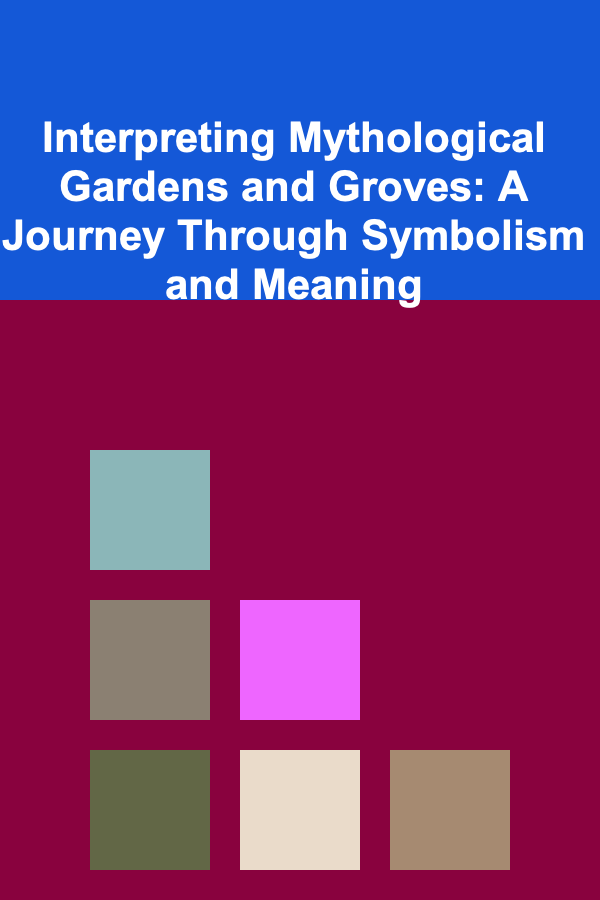
Interpreting Mythological Gardens and Groves: A Journey Through Symbolism and Meaning
ebook include PDF & Audio bundle (Micro Guide)
$12.99$10.99
Limited Time Offer! Order within the next:

Gardens and groves have held a significant place in human imagination and culture since time immemorial. They are not merely collections of plants; they are often imbued with profound symbolic meaning, representing ideals of paradise, power, knowledge, and transformation. In mythology, these spaces become even more potent, serving as settings for crucial narratives, embodying divine presence, and reflecting the underlying principles of the cosmos. Understanding how to interpret mythological gardens and groves requires a multi-faceted approach, considering their historical context, cultural significance, and the specific myths associated with them.
The Garden as Paradise and the Lost Eden
One of the most pervasive representations of gardens in mythology is as a paradise, a state of perfect harmony and abundance. The idea of a primordial garden, often a 'lost Eden,' appears in various cultures, reflecting a collective longing for a time before suffering, death, and separation from the divine. The biblical Garden of Eden is perhaps the most well-known example, a sanctuary of innocence where Adam and Eve lived in harmony with nature and God. Its lush vegetation, flowing rivers, and absence of labor represent a utopian ideal. The serpent's temptation and the subsequent expulsion from the garden symbolize the fall of humanity, the loss of innocence, and the introduction of mortality.
Interpreting the Garden of Eden requires understanding the allegorical nature of the narrative. The garden itself represents a state of spiritual purity and unmediated connection with the divine. The forbidden fruit, often associated with knowledge, symbolizes the awakening of consciousness and the capacity for moral choice. The expulsion is not simply a punishment but a necessary step in human evolution, leading to self-awareness and the potential for moral growth. The garden, therefore, is not merely a literal place but a metaphor for the potential for human enlightenment and the consequences of our choices.
Similar paradisiacal gardens appear in other mythologies. In Zoroastrianism, the garden of Yima (also known as vara), created by the first king Yima to preserve the best of creation from a devastating winter, symbolizes a refuge of life and abundance. Similarly, the Celtic Otherworld, often depicted as a lush and fertile island or a hidden realm, is a place of eternal youth and happiness, accessible only to heroes and those favored by the gods. These gardens, like the Garden of Eden, represent a yearning for a state of perfection and harmony that is often lost or unattainable in the mundane world.
Gardens as Expressions of Power and Authority
Beyond representing paradise, gardens in mythology can also serve as potent symbols of power and authority. Rulers and gods often create elaborate gardens to demonstrate their wealth, control over nature, and connection to the divine. These gardens are not merely aesthetically pleasing spaces; they are carefully constructed expressions of dominance and influence.
The Hanging Gardens of Babylon, though shrouded in legend, are a prime example of a garden intended to impress and intimidate. While their actual existence is debated, the descriptions of these terraced gardens, built by King Nebuchadnezzar II for his homesick wife, illustrate the king's ability to manipulate the natural world on a grand scale. The gardens, with their exotic plants and intricate irrigation systems, were a testament to Babylonian engineering prowess and royal power. They symbolized the king's ability to create a paradise on earth, a tangible manifestation of his authority.
In Greek mythology, the gardens of the Hesperides, where golden apples grew, were guarded by a dragon named Ladon and the Hesperides nymphs. These gardens, located at the edge of the world, represented not only immense wealth (the golden apples) but also the difficulty in attaining such treasures. Hercules' eleventh labor involved retrieving these apples, signifying his triumph over adversity and his claim to divine favor. The garden itself became a symbol of the challenges one must overcome to achieve greatness.
Even in more subtle forms, gardens can express power dynamics. Consider the sacred groves dedicated to specific deities in various cultures. These groves, often located near temples or sanctuaries, were carefully maintained and protected, symbolizing the god's presence and influence. The act of dedicating a grove to a deity was a gesture of reverence and submission, acknowledging the god's power over the natural world and the human realm.
Groves as Sacred Spaces and Sites of Transformation
While gardens often imply a degree of human intervention and control, groves frequently represent a more natural and untamed sacred space. Groves, clusters of trees often considered sacred, are prominent features in many mythologies, serving as sites of ritual, divination, and transformation. Their natural beauty and inherent connection to the earth make them ideal locations for encountering the divine or undergoing profound personal change.
In Celtic mythology, groves held immense significance. Druids, the priestly class of Celtic society, often performed rituals and conducted divination in sacred groves. These groves were considered gateways to the Otherworld, places where the veil between the physical and spiritual realms was thin. Trees themselves were revered as embodiments of ancient wisdom and power, and specific types of trees were associated with particular deities or attributes. Oak trees, for example, were often linked to strength and endurance, while willow trees were associated with healing and intuition. The grove, therefore, was not just a collection of trees but a living temple, a space where one could connect with the divine and gain access to hidden knowledge.
The groves dedicated to the goddess Diana (Artemis in Greek mythology) in Roman and Greek cultures provide another example of the sacred nature of groves. These groves were often located near bodies of water and were considered places of refuge and healing, particularly for women. The goddess Diana was associated with the hunt, the wilderness, and childbirth, and her groves were spaces where women could connect with her power and seek her protection. The grove, in this context, represented a sanctuary from the pressures of patriarchal society, a space where female power and autonomy could be celebrated.
Groves also play a crucial role in narratives of transformation. In Ovid's Metamorphoses, numerous characters undergo transformations within groves. Daphne, fleeing the unwanted advances of Apollo, transforms into a laurel tree in a sacred grove, escaping his pursuit but sacrificing her human form. Actaeon, stumbling upon Diana bathing in a grove, is transformed into a stag and hunted to death by his own hounds. These transformations highlight the power of the grove as a liminal space, a place where boundaries between the human, animal, and divine realms blur. The grove becomes a catalyst for change, often involving a loss of identity or a profound shift in one's relationship with the world.
Symbolism of Specific Plants and Trees
Interpreting mythological gardens and groves also requires an understanding of the symbolism associated with specific plants and trees. Different cultures have assigned different meanings to various flora, reflecting their unique beliefs and values. Understanding these symbolic associations can provide valuable insights into the meaning of a garden or grove within a particular myth or tradition.
The apple, as seen in the Garden of Eden and the gardens of the Hesperides, is a complex symbol with multiple layers of meaning. It can represent temptation, knowledge, immortality, or beauty, depending on the context. In the Garden of Eden, the apple represents forbidden knowledge and the fall from grace. In the gardens of the Hesperides, the golden apples symbolize immortality and the challenges one must overcome to attain it. In Greek mythology, the apple played a central role in the Judgement of Paris, where Paris had to choose the fairest goddess from among Hera, Athena, and Aphrodite, awarding her a golden apple. The apple, in this case, symbolizes beauty, rivalry, and the consequences of choices.
The oak tree, revered in many cultures, symbolizes strength, endurance, and wisdom. Its long lifespan and sturdy branches make it a fitting symbol of resilience and longevity. In Celtic mythology, the oak was considered a sacred tree, associated with the god Dagda and the druids. The Romans also revered the oak, dedicating it to Jupiter, the king of the gods. The oak tree, therefore, represents not only physical strength but also spiritual power and divine authority.
The willow tree, often associated with mourning, healing, and intuition, also holds significant symbolic weight. Its drooping branches and association with water make it a symbol of sorrow and loss. However, its ability to heal and adapt to challenging conditions also represents resilience and the power of intuition. In Celtic mythology, the willow was associated with the goddess Brighid and was considered a sacred tree, symbolizing healing and protection. In some traditions, the willow is also associated with divination and the ability to access hidden knowledge.
Flowers, too, are rich in symbolic meaning. Roses, for example, are often associated with love, beauty, and passion. Lilies can represent purity, innocence, and resurrection. Sunflowers symbolize adoration, loyalty, and longevity. Understanding these floral symbols can enrich our understanding of the emotions and themes evoked by a particular garden or grove.
The Garden as a Microcosm of the Cosmos
At a deeper level, mythological gardens and groves can be interpreted as microcosms of the cosmos, reflecting the order, balance, and cycles of the universe. The arrangement of plants, the presence of water, and the overall design of the garden can all symbolize cosmological principles and the relationship between the human and divine realms.
Ancient Egyptian gardens, for example, were often designed to reflect the structure of the universe. The central pool or canal represented the primordial waters from which all life originated. The trees and plants were arranged to symbolize the various deities and aspects of creation. The garden, therefore, was not merely a place of pleasure but a sacred space that mirrored the divine order of the cosmos.
Chinese gardens, with their emphasis on balance and harmony, also embody cosmological principles. The arrangement of rocks, water, plants, and buildings is carefully planned to create a sense of flow and interconnectedness. The yin and yang principle is often reflected in the contrasting elements of the garden, such as the rough texture of rocks and the smooth surface of water. The garden, in this context, becomes a miniature representation of the universe, a place where one can contemplate the nature of reality and find harmony with the cosmos.
Even seemingly simple groves can reflect cosmological principles. The cyclical nature of the seasons, the growth and decay of trees, and the interconnectedness of all living things within the grove can symbolize the continuous cycle of creation, destruction, and renewal that governs the universe. By observing the natural rhythms of the grove, one can gain a deeper understanding of the cosmic order and one's place within it.
Conclusion: A Journey of Interpretation
Interpreting mythological gardens and groves is a complex and rewarding endeavor. It requires a combination of historical knowledge, cultural sensitivity, and a willingness to explore the symbolic dimensions of these spaces. By considering the specific myths associated with a garden or grove, the symbolism of its plants and trees, and its overall design, we can gain valuable insights into the beliefs, values, and aspirations of the cultures that created them.
Gardens and groves are not merely static settings; they are dynamic and evocative spaces that can transport us to other realms, connect us with the divine, and inspire profound personal transformations. They are reflections of our deepest desires and fears, our hopes and dreams. By learning to interpret these spaces, we can unlock a rich tapestry of meaning and gain a deeper appreciation for the power of mythology and the enduring human fascination with the natural world. The journey of interpretation is a journey of discovery, a journey into the heart of human imagination and the enduring power of nature to inspire and transform us.

How to DIY Your Home Decor with Inexpensive Materials
Read More
How to Organize Vintage Accessories for Easy Access
Read More
How to Sell Used Books on Amazon: A Comprehensive Guide
Read More
How to Use Drawer Organizers for Kitchen Efficiency
Read More
How to Discover Series with Beautiful Cinematography
Read More
Understanding the Impact of Film Festivals
Read MoreOther Products

How to DIY Your Home Decor with Inexpensive Materials
Read More
How to Organize Vintage Accessories for Easy Access
Read More
How to Sell Used Books on Amazon: A Comprehensive Guide
Read More
How to Use Drawer Organizers for Kitchen Efficiency
Read More
How to Discover Series with Beautiful Cinematography
Read More